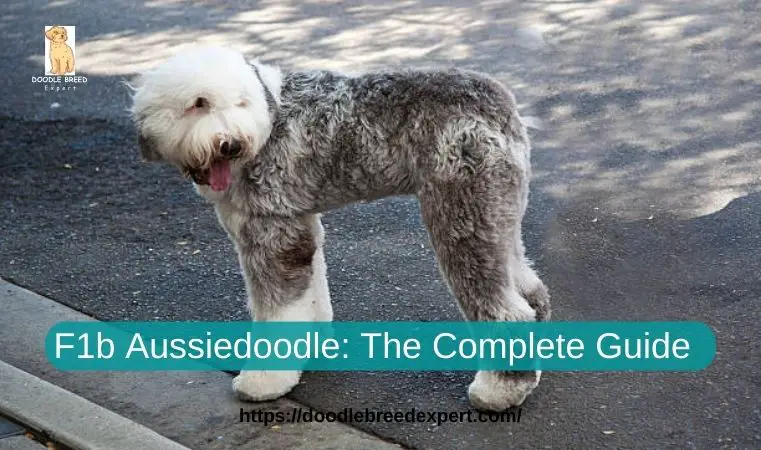The Blue Merle Aussiedoodle is brought about through cross-breeding between an Australian Shepherd and Poodle. It was recognized to be their unique mix starting from the 1900s.
“Merle” describes their distinct coat pattern –tones or bands marbled or mottled with blue, gray, black, and white hues. Additionally, considering their hypoallergenic coat and intellectiveness, they highly cherish this designer breed.
As with every hybrid breed, the traits of a Blue Merle Aussiedoodle come in different forms based on the qualities inherited from his parent breed. In most cases, they are described as smart, social and friendly dogs that consistently require proper exercise and mental engagement.
They’re praised for their devotion and sweetness making them wonderful companions and often the perfect pet choice for families. Nonetheless, just like with any breed, you’d want to know all there is to know about this particular one before welcoming it into your living space.
It should also be noted that this breed is quite active, making them difficult to keep exclusively indoors or in confined spaces.
The cost of these puppies is quite high, with Blue Merle Aussiedoodles usually costing around $10,000, but other avenues are at play, such as adopting from local rescue shelters.
Regardless of the avenue trodden to acquire them, these dogs undertake abundant quality of affection, companionship, and loyalty for you and your family at home.
Blue Merle Aussiedoodle Qualities
A Blue Merle Aussiedoodle is a very bizarre variation of the Aussiedoodle breed. This cross-breed is known to be in size between an Australian Shepherd and a Poodle, as well as shape, type, and colour. The blue merle Aussiedoodle color pattern has a striking appearance, attracting many people.
The blue merle Aussiedoodle notable characteristics include silver grey black white flaking patches on random or mottled patterns of colours. This can have either eye: brown nose: black The standard Saeberlich distinguishes several physical types inherited with each generation based on coat colour, including factoring for blue merle. The texture of their coat can range from wavy to curly, owing to the Poodle parent genetics.
The Blue Merle Aussiedoodle inherits the playful nature of both its parent breeds. They’re well-known for socializing and getting along with other children and pets.
Blue Merle Aussiedoodle’s physical appearance
Physically, Blue Merle Aussiedoodle are an offspring of the Australian Shepherd and the Poodle – two breeds developed over many years to work together as a team. They can be made in any height or weight, depending on how big their Poodle parent is.
Height and weight
Mostly, Blue Merle Aussiedoodles grow from 14 to 23 inches tall and weigh anywhere between 25 to 70 pounds. This makes them medium-sized dogs – fit for apartments or houses with yards.
However, if your Aussiedoodle is bred on a Toy or Miniature Poodle, it will be much smaller in height and weight. The typical toy Aussie stands around 10 inches tall while weighing between 4 to 6 pounds whereas the Mini Aussies stand between 10 to 15 inches tall and weigh 10 to 15 pounds.
The largest size of a Standard Aussiedoodle is usually about 15 inches tall or taller and usually weighs around 40 to 70 pounds.
Coat and Eye Color
The Blue Merle Aussiedoodle is called such because of its unique color, as it is a mixture of silver, grey, black and white patches that give it a mottled or marbled look. As for their eye colors, there can be many variations.
Blue Merle Aussiedoodles commonly have brown eyes, but it’s also possible for them to have blue eyes – many find them particularly striking. In some cases, their eyes may change color as they grow from puppy to adult–for example, they might start with blue eyes that later turn to brown.
Two different colored eyes – this is called heterochromia, and a perfectly healthy condition only adds to their appearance’s uniqueness.
Blue Merle Aussiedoodle Grooming
The Blue Merle Aussiedoodles, like all the Aussiedoodles, need to be groomed regularly to maintain their healthy coat and make them look good. They inherit the coat type from the Australian Shepherd, which may not be the Australian Shepherd’s straight or wavy fur or the Poodle’s tight curls.
Daily Grooming
Blue Merle Aussiedoodles need daily brushing to prevent matting and tangles, especially if their coat is more similar to their Poodle parent. If they have a wavier or straighter coat, similar to an Australian Shepherd, they may not need daily brushing but will still benefit from regular grooming.
Trimming
A Blue Merle Aussiedoodle’s hair should be trimmed every eight to twelve weeks. This can vary depending on the individual dog, how fast their hair grows, and how long the desired of their coat is.
BathingBathing should be needed but not necessarily daily. Too much often can strip the natural oils from their skin and fur, causing dryness and, as a result, potential skin issues. A good rule of thumb is to them once every four to six weeks or if they get particularly dirty.
Ear and Nail CareGet your Aussiedoodle’s ears cleaned regularly with a damp cloth, then dry them properly to avoid moisture getting in and causing infection. Their nails should also be cut regularly so that the dog doesn’t have their claws grow too long and cause discomfort.
Dental Care
Don’t forget about dental hygiene welfare; stinting brushing teeth will preserve the oral health of Aussiedoodles and keep off dental disease.
SheddingThe kind of coat your Blue Merle Aussiedoodle will get will determine whether they shed. Those with bigger curls, like a Poodle, won’t usually shed as much as the hair that sheds gets caught in the curls. Those with wavier or straighter coats may shed more, similar to an Australian Shepherd. Again though, note that no dog breed is truly hypoallergenic and no matter how much shedding a breed happens to have-and, it’ll cause allergies anyways-it can’t make up for having said amount of shedding.
Crate size for your Blue Merle Aussiedoodle
The crate size for your Blue Merle Aussiedoodle should be based on the adult dog’s size. Full-grown Aussiedoodle, typically depending on the size of the Poodle parent, fits well in a 42-inch crate. However, if you have smaller Aussiedoodles such as mini or toy variation selections? Then a smaller crate would be more appropriate. Ensure the crate provides enough space for your dog to stand, turn around, and lie comfortably.
Health
As a general rule, Blue Merle Aussiedoodles are considered healthy dogs. They have an average lifespan of 10 to 12 years, which can be increased with proper care, diet, and regular exercise. Like all breeds, they deal with certain health conditions that may be inherited from their Australian Shepherd and Poodle parents.
Although being a hybrid doesn’t always lessen the probability of taking on specific health risks for breed-related diseases, ensure you’re aware of possible health problems. Blue Merle Aussiedoodles can be at risk to conditions including:
- Von Willebrand’s Disease: A blood coagulation disorder
- Epilepsy: A neurological disease that causes seizures
- Cushing’s disease: An abnormal condition caused by an overproduction of cortisol
- Pancreatitis: Inflammation of the pancreas
- Progressive Retinal Atrophy (PRA): The name given to a group of degenerative diseases affecting the retina in the eyes
- Hip dysplasia, where the hip joint doesn’t create correctly, causing arthritis, is common among many breeds, including Aussiedoodles.
See any change in your dog’s behavior, like limping, reluctance to move, or favoring one leg. Get veterinary advice right away. Regular vet check-ups will also catch health problems early on.
If you buy a Blue Merle Aussiedoodle later than the acquisition date provided by the breeder and there are any noticeable changes in your pup’s behavior, like limping: get your dog checked out at the vet as soon as possible. Regular riggings and checks will allow you to detect potential health issues before they become real problems.
Temperament
Blue Merle Aussiedoodles are full of life. They’re typically friendly with children and other pets, making them the right choice for families. These guys love time cuddling but still enjoy an active lifestyle that includes running and hiking.
Because of their Australian Shepherd heritage, they might sometimes display herding behavior like nipping at heels. However, this habit can be controlled properly in a dog trained as early as possible until adulthood without any problem.
Exercise
Blue Merle Aussiedoodles are an excitable breed that likes to keep active mentally and physically to stay healthy and avoid destructive behaviors. They should spend about 45 minutes daily walking—with playtime and mental stimulation added twice daily. Add dog sports such as agility, which can provide physical and mental challenges.
Training
Preferably, training should start when your Aussiedoodle is around eight weeks old. Your first training should mostly focus on housebreaking and basic obedience. As smart dogs, Aussiedoodles are usually keen learners and don’t take long to respond well to positive reinforcement training methods. Socialization is also a factor here. It would help if you exposed your Blue Merle Aussiedoodle to various people, pets, and environments early on to become balanced dogs in the future.
Diet
Give your Blue Merle Aussiedoodle a balanced and healthy diet. Your dog’s overall health depends upon feeding them meals regularly. Usually, they will need to be fed 3 to 4 times a day until six months, after which they can take two meals throughout the day.
The quantity and kind of food your pooch needs may vary depending on their age, size, and activity level. Always go for high-quality dog foods, and ensure you’re always available with fresh water for your pet’s convenience.
Treats should only be part of a small portion of your dog’s daily caloric intake to prevent obesity. If you have any questions about your dog’s diet or nutritional needs, it is best to talk with a veterinarian.
Conclusion
Blue Merle Aussiedoodles are striking with their original and brilliant appearance and pleasant personality. The many color variations they can develop in their blue eyes and friendly, outgoing nature make them popular with many families and individuals. In addition, Blue Merle Aussiedoodles are also known to be relatively easy to care for, making them great choices for seasoned dog owners and those looking to take up pet ownership.
Numerous images and reviews confirm the Blue Merle Aussiedoodle’s charm and attractiveness for those considering bringing one home. But before bringing one home, you must conduct research just as you would with any other pet. Ensure you are well aware of their dietary, activity, grooming, and disposition requirements.
References:






